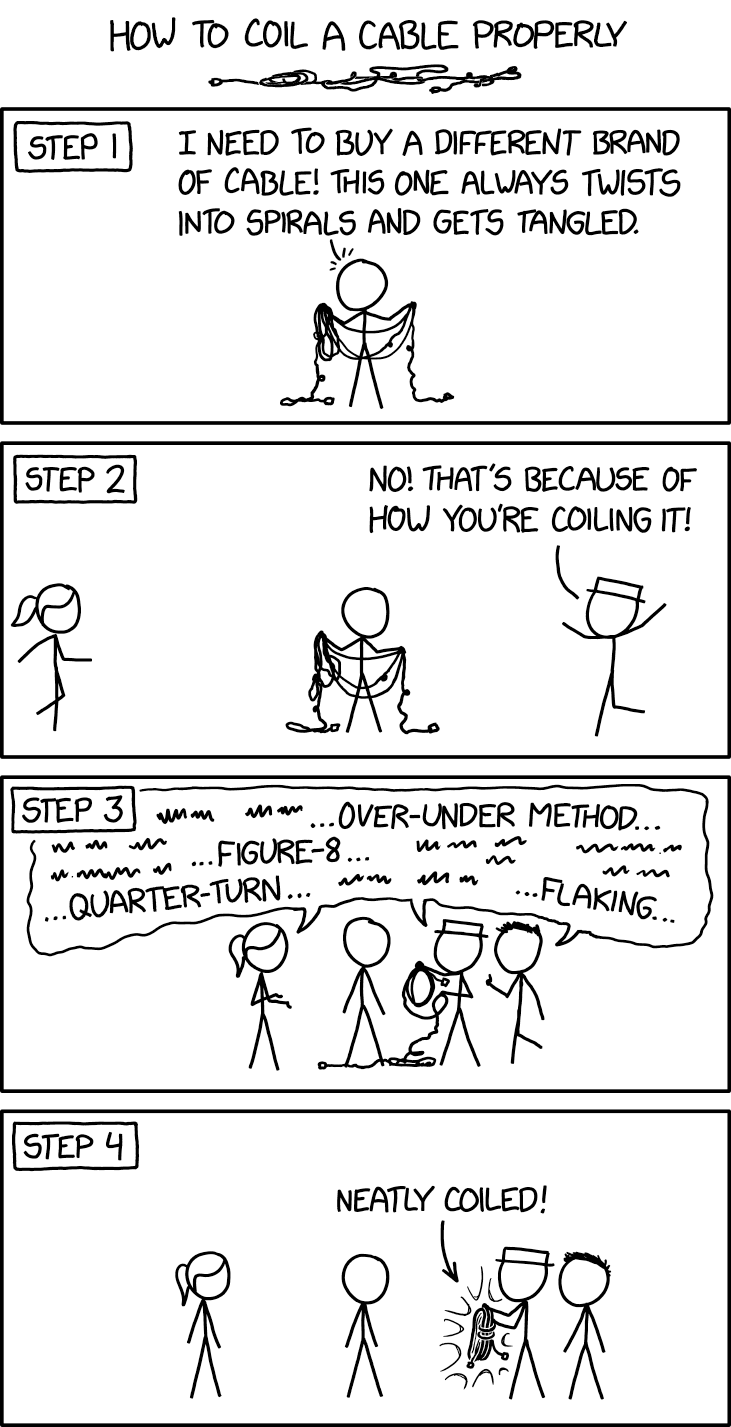Much like the old internet adage: if you want to know the answer to something, confidently state the wrong answer, and inevitably someone who knows the correct answer will chime in to correct you.
Yep, that’s called the Batman smells effect.
I appreciate you!
You used to be able to get people to quickly give you an exact no bullshit straight to the point answer in Linux support forums by making a post along the lines of “Linux sucks because x never works. Windows is obviously superior because it’s possible to make x work”. Someone would then refute all your points and post how to fix your problem.
Exactly.
Nowadays the answer is “BS, x works out of the box on both, RTFM noob” 😛
Betteridge’s law
A cable coil will lay flat and neat, and stay orderly indefinitely if two conditions are met:
-
The coil radius is sufficiently large such that there is little to no tendency to unwind.
-
There is no twist running the length of the cable.
The solution to 1 is simple: just create loops large enough that no energy is stored in the “big spring”.
The solution to 2 is any wrap method which avoids a systematic twist along the cable. If you were an ant walking along the cable, you should find that if you start on the outside surface of the coil, you remain on the outside as you walk the loops.
One method for coiling cables that achieves both goals:
Hold one end of the cable fixed in your off-hand. Let the length of the cable loosely hang such that it may freely rotate. With your dominant hand, slide it down the cable measuring a length which will create a loop large enough that the bend radius doesn’t want to spring back open. Here comes the big trick. As you bring your main hand around to create the loop, use your fingertips and thumb to roll the cable in the direction which eases the twist along the cable. Finish the loop, and repeat until done. The coil should lay flat on a table without wanting to unspool wider, or spring up and launch loops into the air (problem and solution 1 and 2 respectively.)
Practice the finger tip movement. It’s like tying shoes or whistling. Once you get it, you get it.
Also have one end of the cable loose, and push the tension towards that loose end as you coil, unwinding that excess tangle as you go. Coil the cable in the direction in naturally wants to go after this tension has left and it’s no longer fighting you.
I used to shoot live TV in random beaches around the world and this method worked great every time we packed down. We had coil sizes roughly the length of our forearm for super long cables.
I think that’s the “quarter turn” method.
In reality, all the methods are the same:
- Over-under, does one loop, then the next one with a quarter turn, then continues back and forth like that
- Figure 8, does a quarter turn, then pulls one coil up against the other
- Quarter turn, what you described
- Flaking, is just over-under with a longer loop
Holy crap this is spot on. I’ve been doing it for 20 years without thinking but I don’t think I could have articulated it in a meaningful way.
Kudos!
Saved for next time I have to wrap a cable or hose or something.
This guy coils.
This is essentially the over-under method. The idea is that you do a twist in one direction as you make your first loop, then a counter-twist in the other direction, which causes the second loop to sit “under” itself. So your coils follow a pattern of one regular “over” twist, then a reversed “under” twist. So the net result when you uncoil the cable is zero twists, (or at most one twist in the entire length of the cable, if you started and ended the coil with an over twist.)
Professionals use this for coiling, because it helps with cable longevity and running. Your cables never develop the dreaded twists in the first place, because you’ve never introduced more than one twist into them. And in a 50’ run, one twist is negligible and will work itself out as you coil the cable again at the end of the night.
And a figure-8 coil is basically the same thing as over-under, but laid out flat. This is handy for thicker cables that you coil in place. Hubbell Cam feeder cables, for instance. Each cable is as thick as a quarter, and there are up to five of them in a bundle. So it’s incredibly heavy and hard to work with. Instead of dragging the cable to you, you usually have a crew coil it directly onto a cart or into a case. So you’re wheeling the coil around, following the path of the cables, rather than trying to drag the cables to you. But this means you need a way to coil it flat, and a figure-8 solves this. It achieves the same twist-counter twist pattern in a much flatter (but wider) footprint.
The downside to the over-under method is that if one end of the cable gets pulled through the loop, you end up with a series of overhand knots in your cable, spaced evenly across the entire run. That’s why professionals will use velcro cable ties on all of their cables, to ensure the cable ends stay on the correct side of the coil and don’t get pulled through.
Source: I’m an audio technician. In a single shift, I’ll coil anywhere from 500’ to 2500’ of audio cable. Every mic you see on stage probably has either a 25’ or 50’ cable on it, and all of those need to be packed up at the end of the show. On a big gig, I can easily coil half a mile of cable throughout the day. I always joke that the actual show is only 10% of the job. The other 90% is cable management.
-
deleted by creator
Draw the rest of the fucking owl
Over-under ftw!
You heathen! Quarter turn with each loop!
Hey, this is way better than Emacs vs vim.
Of course it is. Why would anyone want to use emacs? Also why would anyone use spaces instead of tabs?
Forgot to mention ham radio guys and firefighters.
I never try to help others coil their cords/rope/hose. Everyone has their own way to do it, and you can never convince them otherwise.
I did this to a cord at work once. They were not amused. https://www.artofmanliness.com/skills/manly-know-how/no-more-tangled-extension-cords-how-to-wrap-up-your-extension-cord-like-a-contractor/
Wow, 4/4 steps are complete bullshit. That’s a rare 100% bullshit score.
I would really add some parachutist to competently derail the discussion.
Next, do a garden hose. That beast is impossible to tame!
Lies. Reverse coil or figure 8 (which is just a sort of spread out reverse coil). Wraps easily, unwrap easily.
Extensible hose with an inner silicone tube and outer braiding.
No matter how you mangle or bunch it up, it springs back and untangles itself the moment you put water in it.
I’m just a little sad that they make it sound confusing and difficult, when it’s not. sigh.
Mobile version:
https://m.xkcd.com/2810/These fools coiling cables. Tidy cables are nice, until they get messy, then they’re a nightmare.
Braiding power leads makes them mess proof and tangle free. Easy to unbraid as much as you need, and quick and easy to redo.
Don’t braid a hose though.
If your alternating positive and negative coils then don’t even talk to me!
I feel personally attacked
posting link instead of img is lame on mobile
We like Randall give him clicks.
Sync handles xkcd links by displaying them as images, with a button for the hover text.
God I missed this app














